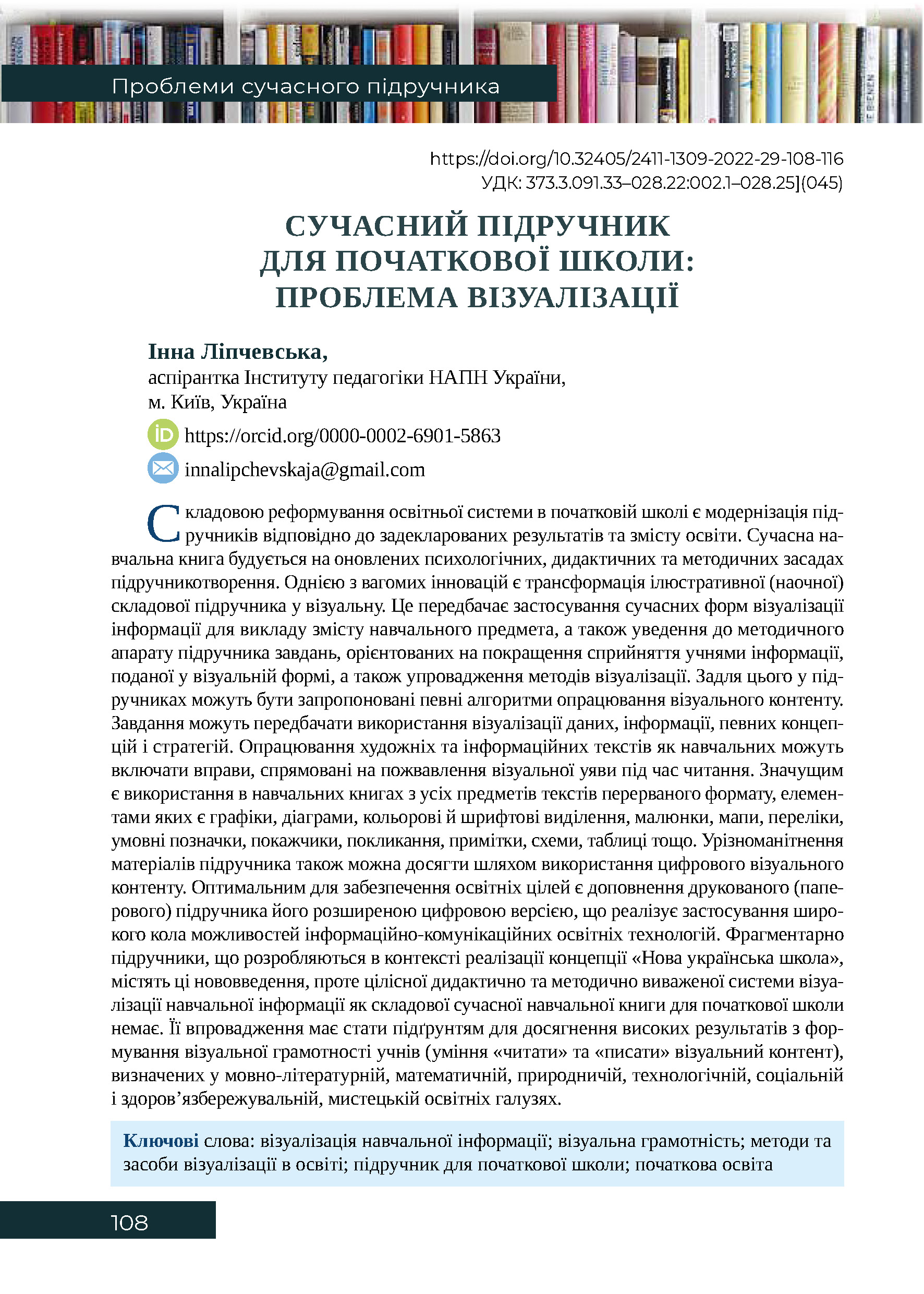
Published 2023-02-06
Keywords
- visualization of educational information,
- visual literacy,
- methods and tools of visualization in education,
- textbook for primary schools,
- primary education
How to Cite

This work is licensed under a Creative Commons Attribution-NonCommercial-ShareAlike 4.0 International License.
Abstract
А component of the reform of the educational system in primary schools is the modernization of textbooks in accordance with the declared results and content of education. The modern textbook is based on updated psychological, didactic and methodological foundations of textbook creation. One of the significant innovations is the transformation of the illustrative (visibility) component of the textbook into a visual one. This involves the use of modern forms of visualization of information for the presentation of the content of the subject, as well as the inclusion in the methodological apparatus of the textbook of tasks aimed at improving students’ perception of information presented in visual form and the introduction of visualization methods. For this purpose, textbooks may offer certain algorithms for processing visual content. Tasks may also include the use of data visualization, information, concepts, and strategies. The development of artistic and informational texts may include tasks aimed at reviving the visual imagination while reading. It is important to use interrupted format texts in educational books at all subjects, the elements of which are graphs, diagrams, color and font selections, drawings, maps, lists, symbols, pointers, links, notes, diagrams, tables, etc. A variety of textbook materials can also be achieved by using digital visual content. Optimal for ensuring educational goals is to supplement the printed (paper) textbook with its expanded digital version, which implements the use of a wide range of information and communication educational technologies. Fragmentary textbooks of the New Ukrainian School include these innovations, but there is no complete didactically and methodologically balanced system for visualizing educational information as a component of a modern textbook for primary schools. Its implementation should become the basis for achieving high results in the formation of visual literacy of students (the ability to “read” and “write” visual content), defined in the linguistic and literal, mathematical, natural, technological, social and health-saving, artistic educational fields.
Downloads
References
- Кодлюк, Я. П. (2004). Підручник для початкової школи: Теорія і практика. Тернопіль: Підручники і посібники.
- Кодлюк, Я. П. (2014). Концептуальні основи побудови підручника для початкової школи. Проблеми сучасного підручника, (14), 284–292.
- Литвинова, С. (2019). Smart kids як технологія навчання учнів початкової школи. Інформаційні технології і засоби навчання, 71(3), 53–69.
- Ліпчевська, І. Л. (2021). Потенціал електронного підручника в сучасній системі початкової освіти. Проблеми сучасного підручника: Ключові компетентності та предметні навички, 129–132. http://lib.iitta.gov.ua/725755/
- Ліпчевська, І. Л. (2022). Визначення сутності вмінь візуалізації навчальної інформації майбутніх учителів початкової школи. Молодь і ринок, (7(205)), 151–155. http://mir.dspu.edu.ua/article/view/266233
- Ліпчевська, І. Л., & Малихін, О. В. (2022). Візуалізація навчальної інформації як складова цифрових підручників для початкової школи. Проблеми сучасного підручника: Навчально-методичне забезпечення освітнього процесу в умовах воєнного часу, 208–211. https://lib.iitta.gov.ua/732111/1/Text1.pdf
- Малихін, О., Арістова, Н., & Рогова, В. (2022). Мінімізація освітніх втрат учнів закладів загальної середньої освіти в умовах воєнного стану: Змішане навчання. Український педагогічний журнал, (3), 68–75. https://doi.org/10.32405/2411-1317-2022-3-68-76
- Пометун, О. І., & Гупан, Н. М. (2014). Проектування шкільного підручника: Вимоги і проблеми. Проблеми сучасного підручника, (14), 564–573.
- Про затвердження Державного стандарту початкової освіти, Постанова Кабінету Міністрів України № 87 (2020) (Україна). https://zakon.rada.gov.ua/laws/show/87-2018-п#Text
- Савченко, O. Я. (2019). Інноваційний потенціал підручника з читання. Український педагогічний журнал, (3), 65–71. https://doi.org/10.32405/2411-1317-2019-3-65-71
- A periodic table of visualization methods. Visual Literacy. https://www.visual-literacy.org/periodic_table/periodic_table.html.
- Baron, N. S. (2021). How we read now: Strategic choices for print, screen, and audio. Oxford University Press.
- De Koning, B. B., & van der Schoot, M. (2013). Becoming part of the story! Refueling the interest in visualization strategies for reading comprehension. Educational Psychology Review, 25(2), 261–287. https://doi.org/10.1007/s10648-013-9222-6
- Malykhin, O., Aristova, N., & Kalinina, L. (2022). Schoolteachers-parents interactions amid distance and blended learning: Two-year experience of overcoming negative influences of covid-19 pandemic. SOCIETY. INTEGRATION. EDUCATION. Proceedings of the International Scientific Conference, 1, 454–464. doi:10.17770/sie2022vol1.6858
- Roam, D. (2008). The back of the napkin: Solving problems and selling ideas with pictures. Portfolio. https://radio.shabanali.com/back-of-the-napkin.pdf
- The art of seeing art. The Toledo Museum of Art. https://www.toledomuseum.org/education/visual-literacy/art-seeing-art.
- Toledo Museum of Art. (2013, 19 листопада). What is visual literacy? . https://www.youtube.com/watch?v=O39niAzuapc
